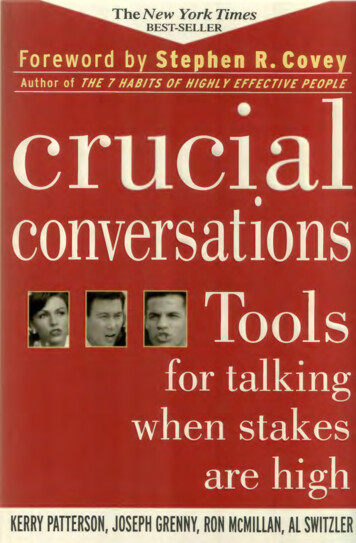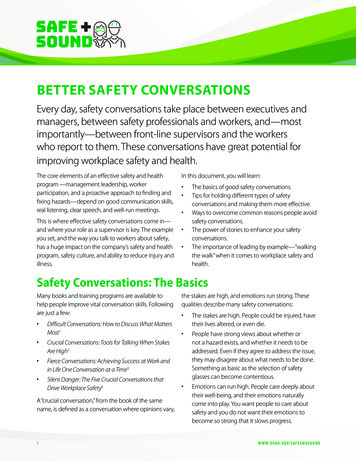
Transcription
Crucial ConversationsRick Capozzi, Learning StrategistRick.Capozzi@gmail.com814.280.3954
Crucial Conversations
Crucial Conversations“They either avoid theconversations (go tosilence), they react but doso poorly by lashing out orgetting angry (go toviolence), or they face themand handle them well.”Crucial Conversations: Tools for Talking WhenStakes are High, McGraw Hill
Objectives1.Experience a problem-solving approachto enhance your own accountability2.Improve performance and ensureexecution through crucial conversations3.Review skills needed to resolve pressingproblems, strengthen relationships,increase quality and improve morale4.Review the principles for holdingeffective crucial confrontations.
Law of CrucialConversations“Anytime you find yourself stuck,there are crucial conversationskeeping you there. Identify thecrucial conversations that you’renot holding or not holding well, andget better at everything.”
Crucial ConversationsStakes are highOpinions varyEmotions arestrong
Crucial ConversationsAvoid(silence)2. Angry(violence)1.
Conversations
The Two StylesSilenceViolence
SilenceCastillo Dominici / FreeDigitalPhotos.net
SilenceMaskingAvoidingWithdrawing
Violence
ViolenceControllingLabelingAttacking
AnalysisWhich are THEYusing?Which are YOUusing?
“Awareness of aproblem is aproblem halfsolved.”
Having Conversations
Having ConversationsRememberthat theseare two-wayconversations
A Safe EnvironmentStep out of the issue and buildsafety before continuingSeek to establish a mutualpurposeSeek to establish mutualrespect
Five stepsShare facts, not opinions, emotions orjudgmentsTell your story so people know yourinterpretationAsk others to share their story andinterpretationMaintain tentativeness throughout theconversationInvite solutions to deal with the issues
1. Share factsShare facts, notopinions, emotions orjudgments
1. Share factsAsk yourself,“Why would arational persondo what theydid?”
2. Tell your storyTell your story sopeople know yourinterpretation
2. Tell your storyDon’t be blindedby your ownpersonalnarrative. Seetheirperspective.
3. Ask others to shareAsk others to sharetheir story andinterpretation
3. Ask others to shareListen to hearthe otherperson’s story
3. Ask others to share“I didn’thear what Isaid thesame wayyouKerrydid.”Benninghoff,PA StateRepresentative
3. Ask others to shareReplacewhat theyheard withwhat youintended tosay.
4. Maintain tentativenessMaintaintentativenessthroughout theconversation
4. Maintain tentativenessDissolvepreexistingemotionalbarriers
5. Invite solutionsInvite solutions todeal with the issues
5. Invite solutionsCreate a“pool ofsharedmeaning”
Having ConversationsRefuse “thesuckerschoice.”Win & Loseare not theonlyoptions.
Having Conversations“And.”
ConversationImage: digitalart / FreeDigitalPhotos.net
Remember “They either avoid the conversation (goto silence), they react but do sopoorly by lashing out or getting angry(go to violence), or they face themand handle them well.”Crucial Conversations: Tools for Talking When Stakes areHigh, McGraw Hill
Thank you!Rick CapozziRick.Capozzi@gmail.com814.280.39541211 Locke Mountain RoadHollidaysburg, PA 16648 USA
effective crucial confrontations. Law of Crucial Conversations "Anytime you find yourself stuck, there are crucial conversations keeping you there. Identify the . Crucial Conversations: Tools for Talking When Stakes are High, McGraw Hill. Thank you! Rick Capozzi Rick.Capozzi@gmail.com 814.280.3954










